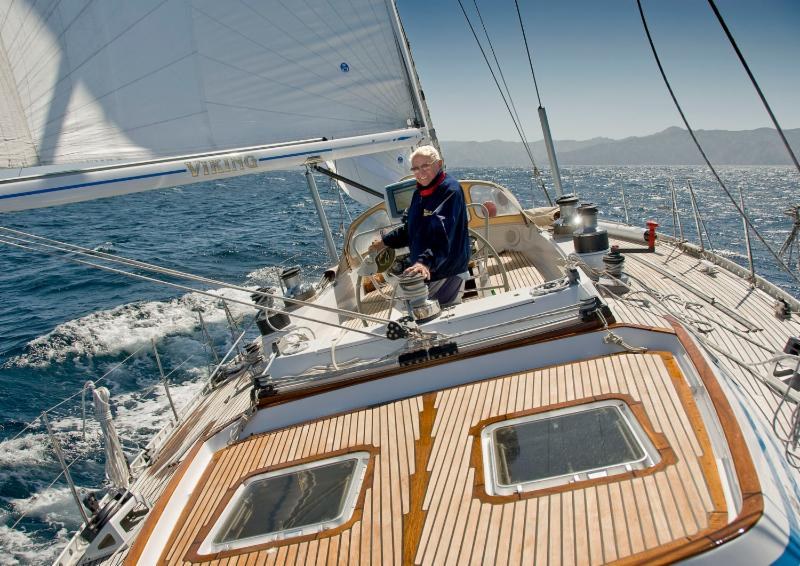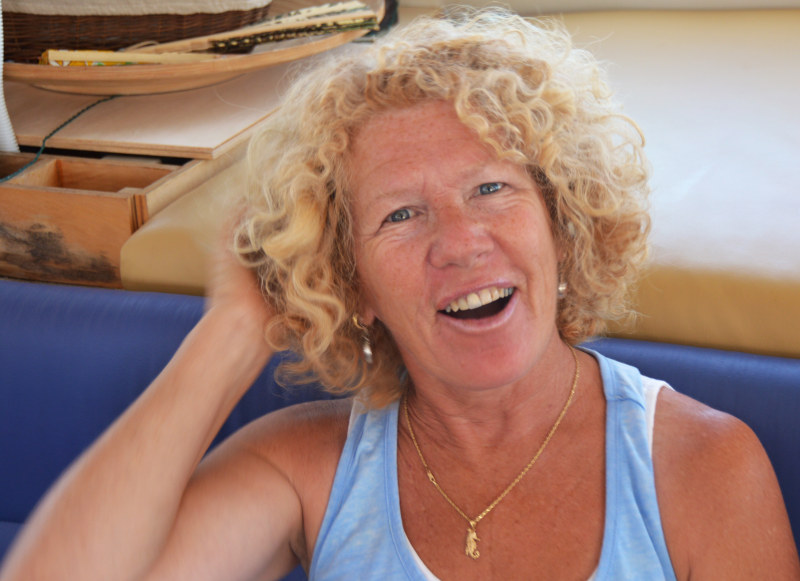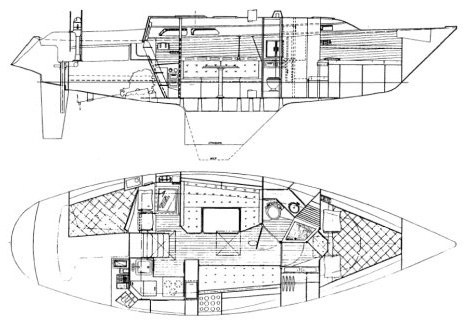
Octogenarian Homecoming

©2014Latitude 38 Media, LLC
As the 14 finishers of this month’s Singlehanded TransPac can confirm, sailing alone from the West Coast to the Hawaiian Islands is a substantial personal accomplishment. Last spring San Pedro-based Karl Burton made a similar crossing aboard his Swan 61 Viking, but without the safety net of an organized race. For Burton, who was then 85 years old, arriving was particularly sweet, as it was his fourth successful California-to-Hawaii solo crossing.
He was apparently so thrilled, in fact, that he decided to continue on around the world alone. Now on the home stretch of a very fast lap around the planet, he’s expected to arrive at the L.A. Lighthouse before noon on August 2 — only 15 months after setting out — where he will be met by friends and fans from his Cabrillo Beach YC. Club members encourage other SoCal boaters to join them in escorting Viking back to her home berth. (Gather around 11:30 a.m. near the lighthouse.)
Burton’s sailing career spans more than 76 years, during which time, we’re told, the idea of circumnavigating solo was always in the back of his mind. His wife Jolene has shared his sailing passion for more than 50 of those years, and she’ll be at the CBYC guest dock to greet him with a champagne toast. Although we may not make it to the celebration, we’ll also be toasting Burton on that day: "Good job Karl. You are truly an inspiration!"
(For info on the homecoming shindig call CBYC at 310-519-1694.)
Capsized by Blue Whales

©2014 Latitude 38 Media, LLC
Capt. CiCi Sayer is no stranger to excitement and danger. She’s done a couple of deliveries to Mexico, did the stormy Caribbean 1500 nicknamed ‘Nightmare on Night Heron‘, and between 2003 and 2010 drove Two Harbors (Catalina) shoreboats — including during the bacchanalian, Buffalo Milk-powered Buccaneer Days.
Seeking what she believed would be a more peaceful life, she took up residence aboard her Cal 29 in San Diego’s America’s Cup Harbor, bought a 21-ft Zodiac inflatable with a 150-hp outboard, and started offering Offshore Blue Adventure whale watching tours. Business has been good.
"There are two whale-watching seasons in San Diego," she told Latitude during an interview aboard Profligate. "You get the gray whales December through April, and from July to October — and last year until December — you get the blue whales. In terms of mass, the 80-ft-long blue whales are the largest animals ever on earth."
The whale-watching life has been pleasant and peaceful — until the morning of July 2, when she took wildlife photographer Dale Frink out in search of blue whales. The two went to the south end of Nine-Mile Bank, about 12 miles southwest of Pt. Loma. After photographing some dolphins, they smelled some krill, and soon they saw spouts from two blues that Sayer estimates were 80 feet long. Maintaining more than the 100-yard federally mandated distance from the whales, they watched until the blues went deep. Having gotten some nice tail shots, and knowing the whales could be down for seven to 20 minutes, they took off after bottlenose dolphins. Everybody was happy.
After five or 10 minutes, Frink wanted to get more photos of the blues. When they got to within 150 yards of two blues lunge-feeding on the surface, they stopped and took photos. When blues lunge-feed, they strain through 50,000 gallons of water at a gulp, water that is hopefully heavily laden with one-inch krill. After a time, the two whales dove again.
It’s hard to imagine something 80 feet long sneaking up on you, but that’s what happened next.
"One of the whales, with his giant mouth wide open, came up just a few feet behind my boat," Sayer remembered, "then oscillated on his back as blues do when they feed. When he came down, his lower jaw, which was now higher than his upper jaw, slammed onto the big outboard."
The inflatable rocked violently from one side to the other, "until the second whale came up and banged the starboard side of the boat, completing the capsize in just seconds." Frink was able to hang onto the inflatable, while Sayer, wearing a PFD, was driven 60 feet away by fluke-generated turbulence before she was able to surface."
"It happened so fast all I could think was, ‘Oh shit!’" says Sayer.
The whales continued to feed and bump into the inflatable as Frink hung on. Although she kept her distance, Sayer was nearly grazed by the mighty fluke of one whale.
The entire sequence was captured by a woman aboard a sportfishing boat that had also been whale-watching in the area. Sayer’s head looks so small bobbing above the water in front of the monster blues. The sportfishing boat didn’t attempt an immediate rescue because they didn’t want to endanger the whales or their boat. This wasn’t a problem for the shaken Frink or Sayer, as the water was a relatively warm 68 and calm, and they were both wearing PFDs. Eventually the whales moved on, Frink and Sayer were rescued, and the inflatable was towed back to San Diego.
The most dramatic footage of the incident was taken by Dale’s GoPro camera mounted on the inflatable’s console. (That’s the whale’s mouth early in the video.)
"My personal feeling is that behavior of the blues, who were almost hunted to extinction with the advent of motorized vessels, has changed in recent years," says Sayer. "They don’t seem to view vessels as predators anymore. In addition, they seem to be coming much closer to shore than they previously did, which may be a function of their following the krill that they feed on."
Sayer says she’s never seen or experienced any hostile whale behavior, the closest being last winter when her boat was approached, then followed, by a gray. In this case, she believes the blues were just feeding and she was in the wrong place at the wrong time. "It was a one-in-a-million thing," she concludes.
Although shaken by being in the water next to two 80-foot animals, Sayer is eager to resume her whale-watching tours.
Baja Ha-Ha XXI
Help Stop the Leak on My Ericson 35
"I just completed a solo passage across the Atlantic aboard my 1971 Ericson 35 MK II," reports Miles Gerety from Lagos, Portugal. "The first leg was last August from Noank, CT, to the Azores. The second was this June from the Azores to Lagos, Portugal.

©2014Latitude 38 Media, LLC
"Throughout my crossing I had a persistent leak near the aft section of the keel. The leak stopped in calm weather. While in the Azores, I found that the aft part of the keel, which is hollow, was full of water. So I drilled some holes, drained it, and injected epoxy. My repair may have slowed the leak, but hasn’t stopped it. Have any Latitude readers had this same problem with their Ericson 35? Does anybody have any suggestions?" Write to Miles here.
